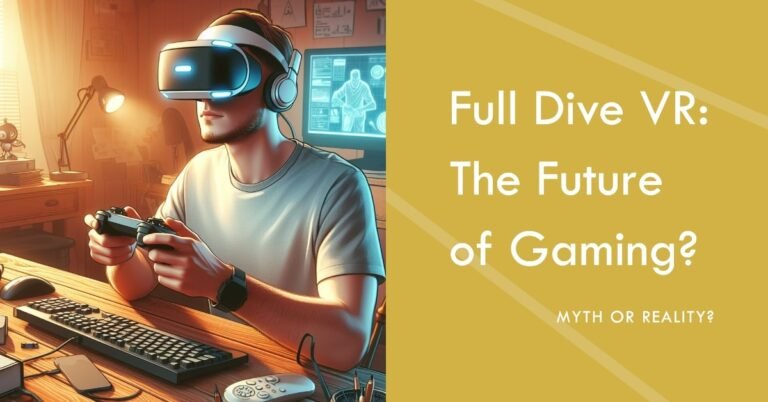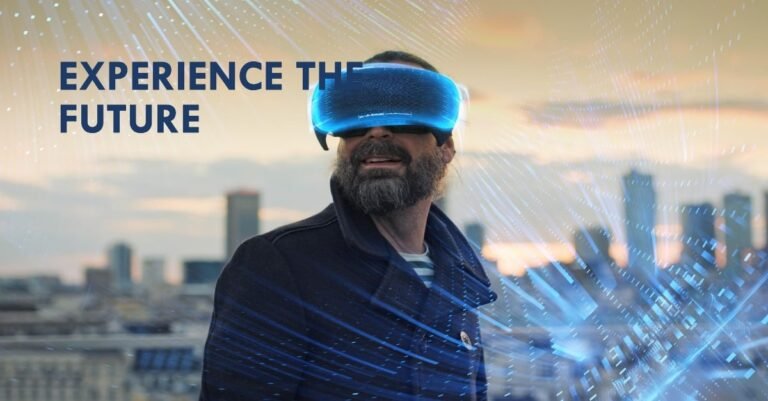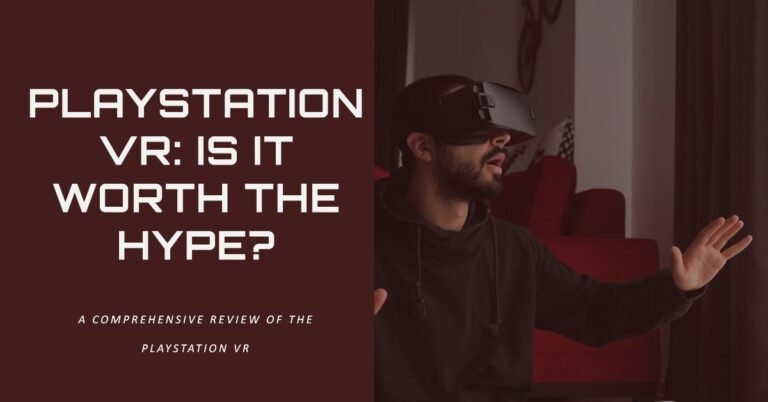VR for Phobias: How This Tech is Turning Fear into Fun!
Imagine conquering your fear of heights while relaxing on your couch, or facing your social anxiety in a completely controlled environment. Sounds too good to be true, right? Well, thanks to advancements in virtual reality (VR) technology, this is exactly what’s possible! VR for phobias is revolutionizing the way we approach anxiety disorders, offering a safe, engaging, and even fun way to overcome your fears.
What Exactly is VR for Phobias?
VR therapy throws you headfirst into a computer-generated world. Using a VR headset and controllers, you can explore virtual environments that mimic real-life situations that trigger your phobias. Imagine standing on a virtual balcony overlooking a breathtaking cityscape, or giving a presentation to a captivated virtual audience. VR for Phobias allows you to confront your fears gradually, in a safe space, with a therapist by your side to guide you through the process.
Here’s the answer to your question: VR for Phobias: How This Tech is Turning Fear into Fun! Lies in its ability to create a safe and immersive environment where you can gradually confront your fears in a controlled way. By gamifying the experience and incorporating elements of fun and challenge, VR therapy can make overcoming phobias less daunting and more engaging.
What Is Virtual Reality In Phobia Exposure Therapy?
Virtual reality (VR) in phobia exposure therapy is a cutting-edge technique that utilizes computer-generated environments to help people confront their fears in a safe and controlled setting. Here’s a breakdown of how it works:
- Immersive Experience: Imagine yourself standing on a virtual balcony overlooking a breathtaking cityscape if you have a fear of heights. Or giving a presentation to a friendly, virtual audience, if public speaking makes you anxious. VR creates a realistic and immersive experience that allows you to gradually expose yourself to your phobias.
- Gradual Exposure: Unlike traditional exposure therapy, which might involve directly facing your fears in the real world, VR allows therapists to carefully design experiences that progressively increase in intensity. This lets you build confidence and coping mechanisms at your own pace, reducing the risk of overwhelming anxiety.
- Safe Environment: A key advantage of VR is the safety it provides. If you’re afraid of spiders, for example, you can encounter virtual spiders in a controlled setting without any real danger. This allows you to practice relaxation techniques and learn to manage your anxiety in a risk-free space.
- Increased Engagement: VR’s interactive nature makes exposure therapy more engaging than traditional methods. Instead of simply talking about your fears, you become an active participant in your recovery. Some VR programs even incorporate gamification elements, turning exposure into a series of challenges you can conquer, making the process more enjoyable.
VR for Phobias: How This Tech is Turning Fear into Fun! isn’t just a catchy phrase. VR therapy can genuinely make overcoming phobias a more interactive and engaging experience.
VR for Phobias: How Tech Turns Fear into Fun!
In a nutshell, VR for phobias uses computer-generated simulations to gradually expose you to your phobias in a safe and controlled virtual environment. Here’s the magic: these simulations can be tailored to your specific fears, allowing you to confront them at your own pace.
For instance, if you’re terrified of spiders, you might start by encountering a virtual spider in a jar, then progress to seeing one crawling on a table in a virtual living room. As you master each level, the virtual environment becomes more challenging, helping you build confidence and extinguish your fear response.
But VR for phobias goes beyond just exposure. Many programs incorporate elements of cognitive behavioral therapy (CBT), which helps you identify and challenge negative thought patterns associated with your fear. By combining exposure with CBT techniques, VR therapy tackles phobias at their root, leading to long-lasting results.
Science Behind VR for Phobias – How is VR used in therapy?
So, how exactly does VR for phobias work its magic? It all boils down to the immersive nature of the technology. When you wear a VR headset, you’re transported to a completely different world. Your brain is tricked into believing that the virtual environment is real, which triggers the same physiological responses as if you were facing your actual phobia.
However, there’s a crucial difference: you’re in complete control. If things get too intense, you can simply take off the headset and step back into the real world. This sense of safety allows you to gradually expose yourself to your fears without experiencing overwhelming anxiety.
Real-Life Victories: How VR is Transforming Lives
Let’s take a look at some common phobias and how VR therapy can help:
- Acrophobia (Fear of Heights): Imagine yourself scaling a virtual mountain or walking across a precarious virtual plank. VR therapy allows you to experience these situations in a safe and controlled way, gradually increasing the difficulty as you progress.
- Arachnophobia (Fear of Spiders): In a VR environment, you can encounter virtual spiders in a variety of settings, starting from a distance and progressing to closer encounters. This allows you to learn to manage your anxiety and develop coping mechanisms.
- Agoraphobia (Fear of Open Spaces): VR therapy can create virtual simulations of crowded marketplaces or busy streets, allowing you to practice relaxation techniques and build your confidence in navigating these situations.
The success stories of VR for phobias are truly inspiring. Take Jessica, for example, who used VR therapy to overcome her debilitating fear of public speaking. Jessica used to dread presentations at work, experiencing panic attacks and crippling stage fright. However, after undergoing VR therapy, which involved giving virtual presentations to increasingly large audiences, Jessica was able to deliver a real-life presentation with newfound confidence.
Another example is Michael, who battled a lifelong fear of heights. Through VR therapy sessions that simulated climbing a virtual mountain, Michael was able to manage his anxiety and eventually conquered his fear by taking a real-life hike. These are just a few examples of how VR for phobias is empowering people to take back control of their lives.
Benefits of VR for Phobias
Phobias can be debilitating, hindering you from experiencing life to the fullest. But what if you could confront these fears head-on in a safe, controlled environment? Enter Virtual Reality (VR) for phobias, a revolutionary approach transforming how we tackle anxieties. Here’s a deep dive into the benefits of VR for phobias:
1. Safe and Controlled Exposure:
Unlike traditional exposure therapy, which involves directly facing your fears in the real world, VR offers a risk-free setting. Imagine confronting your fear of heights by scaling a virtual mountain, or managing your fear of public speaking by giving a presentation to a friendly, virtual audience. VR for phobias lets you gradually expose yourself to phobias without the anxiety of real-world consequences. This controlled environment allows you to practice coping mechanisms and build confidence at your own pace.
2. Gradual Desensitization:
VR therapy excels at gradually desensitizing you to your phobias. Therapists can meticulously design virtual experiences that progressively increase in intensity. This allows you to build resilience and coping skills as you navigate these simulated scenarios. Starting with less anxiety-provoking situations and gradually progressing to more challenging ones fosters a sense of accomplishment and empowers you to manage your anxieties in a controlled way.
3. Increased Engagement and Enjoyment:
One of the biggest advantages of VR for phobias is its engaging nature. It’s more than just talking about your fears; VR makes you an active participant in your recovery. Imagine conquering virtual challenges as you overcome your phobias. Some programs even incorporate gamification elements, turning exposure into a series of quests you can conquer, making the process more interactive and even enjoyable.
4. Increased Effectiveness:
Studies have shown VR therapy to be highly effective in treating phobias. Compared to traditional methods, VR for phobias can lead to significant reductions in phobic symptoms. The immersive and controlled environment allows for deeper engagement and more targeted exposure, potentially leading to faster and more lasting results.
5. Accessibility and Flexibility:
VR therapy is becoming increasingly accessible. With the growing affordability of VR headsets and the development of VR therapy apps, treatment can be more readily available. Additionally, VR therapy offers flexibility. Sessions can be conducted in a therapist’s office or even at home, making treatment more convenient and personalized.
6. Tailored Treatment:
VR therapy can be customized to address specific phobias. Whether it’s fear of heights, public speaking, spiders, or enclosed spaces, VR programs can be tailored to create scenarios that directly target your anxieties. This targeted approach allows for a more focused and effective treatment plan.
Is VR for Phobias Right for You?
If you’re struggling with a phobia that’s impacting your daily life, VR therapy could be a game-changer. Here are some signs that VR for phobias might be a good fit for you:
- Your phobia is causing significant distress or interfering with your daily activities.
- You’ve tried traditional therapies without success.
- You’re looking for a safe and controlled way to confront your fears.
- You’re open to trying new and innovative approaches to treatment.
Can VR help Panic attacks?
Yes, VR has the potential to help with panic attacks, though it’s not a direct fix. Here’s why:
- Exposure Therapy: VR excels at exposure therapy, a core technique for phobias and anxiety disorders. While panic attacks themselves aren’t phobias, the underlying anxieties that trigger them can be. VR can create safe, controlled environments to gradually expose you to situations that induce anxiety, helping you learn to manage those anxieties and potentially reduce the frequency and intensity of panic attacks.
- Relaxation Techniques: Some VR programs focus on relaxation techniques. They might transport you to calming natural environments or guide you through mindfulness exercises, all within the VR world. By practicing relaxation in VR, you can develop these skills to use during a panic attack in the real world.
It’s important to note:
- VR for panic attacks is still under development, and more research is needed.
- It’s likely most effective when combined with traditional therapy like Cognitive Behavioral Therapy (CBT).
- If you experience frequent panic attacks, consulting a mental health professional is crucial.
Here are some next steps:
- Talk to your doctor or therapist about VR therapy as a potential tool to manage your panic attacks.
- They can help you determine if VR is right for you and recommend resources or qualified therapists specializing in VR exposure therapy.
Alternative Treatments for Panic Attacks:
- Cognitive-Behavioral Therapy (CBT): CBT helps identify and change negative thought patterns that contribute to panic attacks.
- Medication: Anti-anxiety medications can help manage symptoms of panic attacks.
If you’re struggling with panic attacks, talk to your doctor or a mental health professional. They can create a personalized treatment plan that’s right for you, which may or may not include VR therapy.
Remember, VR can be a helpful addition to your treatment plan, but it’s not a replacement for professional medical advice.
When was VR first used to treat phobias?
The exact year is up for debate, but research suggests VR therapy for phobias emerged in the early to mid-1990s. Here’s a closer look:
- Pioneering Ideas: The concept of using VR technology for psychological disorders likely began in the early 1990s at the Human-Computer Interaction Group at Clark Atlanta University.
- First Known Experiments: Around 1992, researchers there conducted pilot studies using VR to treat phobias like fear of flying, heights, and specific situations.
- Published Research: The first formal study on VR for phobias appeared around 1995, solidifying its potential as a therapeutic tool.
While VR wasn’t the original purpose behind the technology, its adaptability for mental health interventions became clear in the 1990s. This period marked the beginning of VR’s exciting journey in helping people overcome phobias.
Taking the First Step: Exploring VR Therapy Options
If you’re interested in exploring VR therapy for phobias, here’s what you can do:
- Talk to your doctor or a mental health professional. They can help you determine if VR therapy is right for you and recommend qualified therapists who specialize in VR phobia treatment.
- Research VR therapy programs. Many therapy centers and mental health professionals are now offering VR therapy for a variety of phobias. Look for programs that are tailored to your specific fear and utilize evidence-based practices.
- Consider the cost. While VR therapy can be expensive, many insurance companies are starting to cover it. Talk to your insurance provider to see if VR therapy is covered under your plan.
Here at ARVRRealm, we believe that VR has the potential to revolutionize mental healthcare. VR for phobias is just one example of how this technology is being used to help people live happier, healthier lives.
FAQs: Your VR Phobia Therapy Questions Answered
Here are some of the most frequently asked questions about VR for phobias:
Is VR therapy safe?
VR therapy is generally considered safe for most people. However, it’s important to consult with a healthcare professional before starting any new treatment, especially if you have any pre-existing medical conditions.
How long does VR therapy take?
The length of VR therapy treatment varies depending on the severity of your phobia and your progress. However, most programs typically last for several weeks to a few months.
Is VR therapy expensive?
The cost of VR therapy can vary depending on location and the therapist. However, many insurance companies are starting to cover VR therapy for phobias.
Are there any side effects to VR therapy?
Some people may experience mild side effects like nausea or dizziness during VR therapy. These side effects are usually temporary and go away on their own.
What if I don’t have access to VR equipment?
VR technology is becoming increasingly affordable and accessible. There are also VR therapy apps available for smartphones that can be used in conjunction with a VR headset.
Conclusion
Don’t let phobias control your life. VR for phobias offers a safe, effective, and even fun way to overcome your fears and embrace new experiences. VR for Phobias: How This Tech is Turning Fear into Fun! is more than just a tagline; it’s a call to action. Take control of your life today and explore the possibilities of VR therapy.






